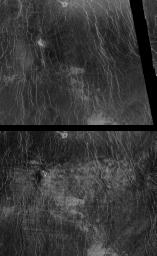Venus - Comparison of Left and Right Looking Views of Imdr Region
Caption:
As the Magellan mission has progressed, areas of Venus have become accessible to the imaging radar system for a second look. During Magellan's second 243-day global mapping cycle, the spacecraft was rotated 180 degrees to view the surface from the opposite direction. This pair of mosaics show a region of Venus 575 kilometers (356 miles) by 460 kilometers (285 miles) as viewed in March, 1991 from the left or west (top image) and in November, 1991 from the right or east (bottom image). The image is centered at approximately 48 degrees south latitude, 230 degrees east longitude in the Imdr region of Venus. The incidence angle of the radar beam with the surface for both observations was approximately 25 degrees from vertical. The dark band near the right edge of the March image is due to a missing segment of data from one orbit. Much of the surface appears different in the two observations. Some of the darkest areas in the top image appear patchy and bright in the bottom image. In addition, east-west trending, alternating bright and dark bands in the lower left part of the bottom image are nearly or completely invisible in the top image. Magellan scientists are currently evaluating these apparent differences to understand their origin. Two theories have been developed. In one interpretation, the right patches in the November (bottom) image are reflections from facets of surface material that are oriented toward the east with a slope of approximately 25 degrees. This would lead to strong mirror-type reflections that are only visible from the east, the direction from which the surface was viewed in November. Under the second interpretation, the surface itself is proposed to have changed between the image acquisitions. It is suggested that materials on the surface had been rearranged sometime during the 8-month period, possibly by near-surface winds. Under this interpretation, the apparent brightening of the surface is explained as a result of the removal of loose material such as dust or sand, exposing a rougher, rockier surface that would appear brighter in a radar image. Magellan scientists hope to obtain a third view of this area in July, 1992, under a viewing geometry similar to the earlier data. This should provide the information necessary to distinguish between the "viewing direction" and "surface change" interpretations.
Cataloging Keywords:
| Name |
Value |
Additional Values |
| Target |
Venus |
|
| System |
|
|
| Target Type |
Planet |
|
| Mission |
Magellan |
|
| Instrument Host |
Magellan |
|
| Host Type |
Orbiter |
|
| Instrument |
Imaging Radar |
|
| Detector |
|
|
| Extra Keywords |
Dust, Grayscale, Radar, Rotation |
| Acquisition Date |
|
| Release Date |
1996-03-14 |
| Date in Caption |
|
|
| Image Credit |
NASA/JPL |
| Source |
photojournal.jpl.nasa.gov/catalog/PIA00260 |
| Identifier |
PIA00260 |

 Planetary Data System
Planetary Data System
